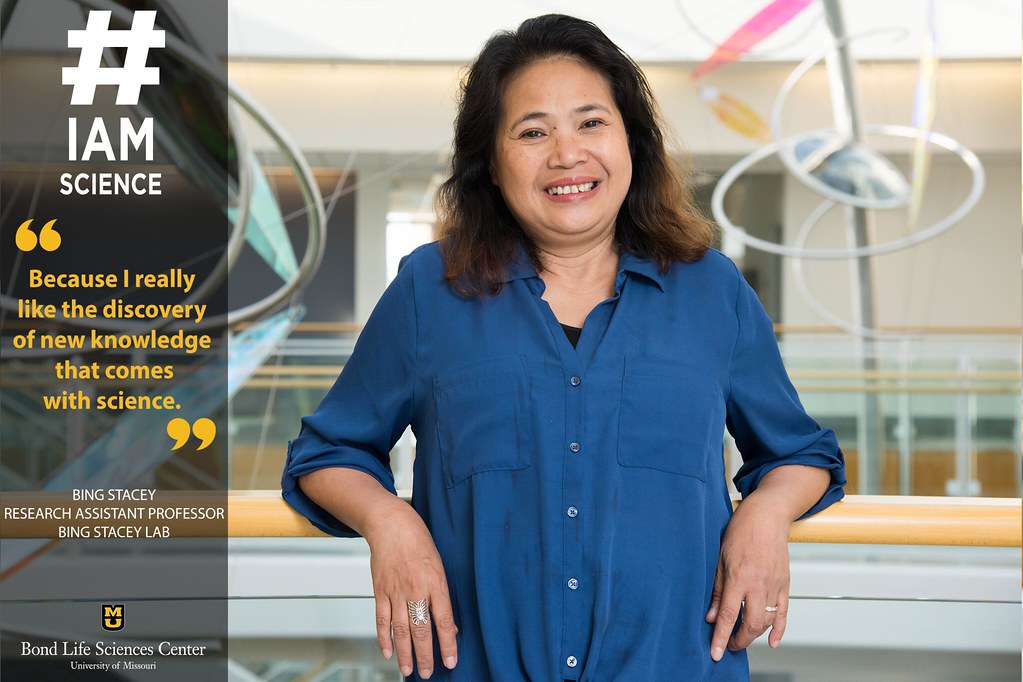News
#IAmScience Bing Stacey

By Lauren Hines | Bond LSC
Bing Stacey works on her soybean genetics papers in her
office with the company of a plant on the windowsill and a large tropical photo
of the Philippines on the second floor of Bond LSC. For the past few years, Bing
Stacey has been working towards uncovering the secrets of soybean genes.
That work aims to
identify what different genes do within the soybean genome so that they can be
manipulated and create higher crop yields. Soybeans are a major source of
cooking oil and protein in animal feeds.
Even though Bing
Stacey has been at Bond LSC for over a decade as part of the lab of her
husband, Gary Stacey, she got her own lab about six years ago when she received
her own funding.
Walter Gassmann,
interim director for Bond LSC, collaborated with Bing on a project when she was
still part of the Gary Stacey lab.
“I said she worked in Gary’s lab, but she was very much the
driver of that project,” Gassmann said. “It’s not like she needed to be told
what to do. She’s a very experienced biologist.”
Bing Stacey started her research career abroad as a research
assistant at the International Rice Research Institute in the Philippines. In
1989, she went to school in Vermont and quickly transferred after finding how
cold Vermont was. By the way, she says Missouri is slightly better.
After getting her Ph.D. in microbiology from the University
of Tennessee, she found her interest in plants during her post doctorate. Finally,
in 2002, Bing found herself at Bond LSC.
“I
see my research as facilitating gene discovery to improve agronomic traits of
soybeans,” Bing Stacey
said.
Currently Bing Stacey’s work identifies which genes are
responsible for which phenotypes or physical traits in soybean plants.
“The
genome of the soybean is pretty complex and redundant,” Bing Stacey said. “So,
it’s kind of hard to discover genes that are important for improving agronomic
traits of soybean.”
More
specifically, she is studying possible genes that could control plant size and
the number of seeds in each pod.
So far, she has
found the gene controls for vitamin E content and the gene that matches a
quantitative trait locus (QTL) found in another study.
“There is a major QTL that has been published,” Bing Stacey
said. “The Chinese actually have been mapping them. I think we have the gene
for that QTL…So, my research has the potential to get to the genes that are
influencing important agronomic traits.”
Bing Stacey uses
fast neutron and CRISPR CAS9 methods to target certain genes and prove they are
responsible for causing a certain physical trait. Fast neutron and CRISPR are
helpful because they’re able to locate, target and edit specific genes to
establish relationships between traits and their genes.
She says she’s
“really quite excited” and “strongly believes” in these methods for achieving
her goals.
After having the
chance to go her own way, Bing Stacey has found success in her work.
“I
was very glad for her to get that non tenure track position a few years ago,”
Gassmann said. “She’s always been independent minded, and now she has more
independence.”
Even though Bing Stacey has already made great strides in finding
the links between phenotypes and genes in the soybean genome, there is still a
lot left to uncover.
“I think it’s the discovery,” Bing Stacey said. “[I really
like] the discovery of new knowledge that comes with science.”